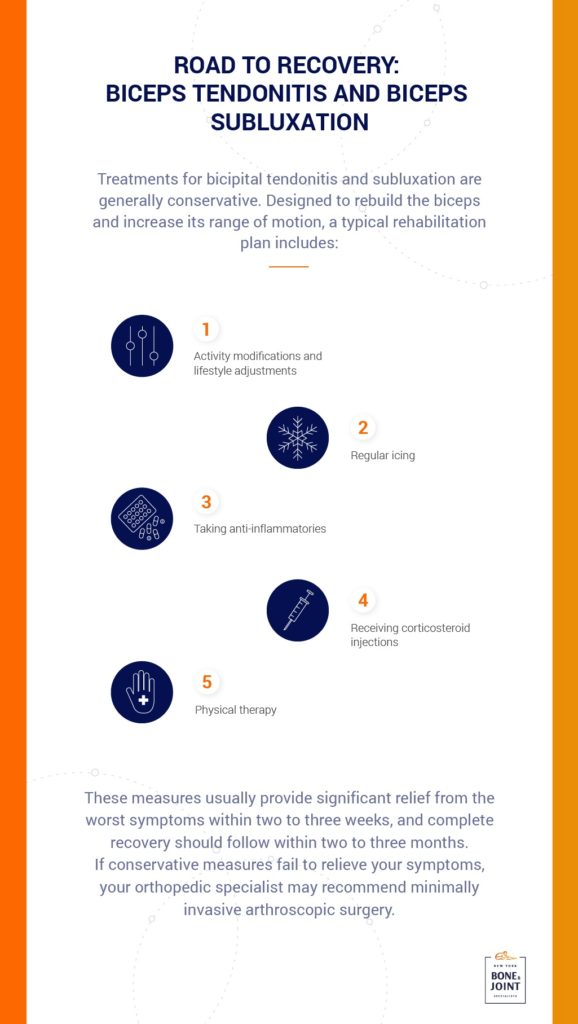Whether you’re powering through your morning CrossFit session in Brooklyn, hauling groceries up a fifth-floor walk-up in Manhattan, or spending long hours at a computer in Midtown, your biceps work overtime in New York City. When repetitive motions and urban demands lead to persistent shoulder or elbow pain, you may be experiencing bicep tendonitis—a common condition affecting active New Yorkers across all boroughs.
Bicep tendonitis affects many New Yorkers annually, regardless of their level of physical activity. At New York Bone & Joint Specialists, our board-certified orthopedic surgeons and sports medicine physicians specialize in diagnosing and treating both proximal and distal bicep tendonitis. We understand that New Yorkers need effective, efficient treatment that gets them back to their demanding lifestyles.
Below, we’ll discuss just what’s happening to your bicep muscle when this injury occurs and how we can help you heal and recover.
Understanding Bicep Tendonitis: Anatomy and Causes
To understand bicep tendonitis, we first need to know the anatomy of the bicep muscle. The bicep muscle features two distinct heads, the long and short head. These ‘heads’ converge into tendons attaching at both the shoulder (proximal) and elbow (distal).
In bicep tendonitis, these tendons become inflamed and irritated. Pain in the bicep tendons like this comes in two forms: acute inflammation (called true tendonitis) and chronic degradation of the muscle (called tendinosis).
Proximal bicep tendonitis, affecting the shoulder attachment, represents the most common form our shoulder specialists treat. This condition typically develops gradually through repetitive overhead motions—think reaching for subway handholds, lifting boxes overhead, or performing excessive overhead pressing in the gym.
Distal bicep tendonitis involves the elbow attachment and is not as common but can be more debilitating. The condition also develops gradually, and comes from repetitive gripping and lifting motions—think of construction work or a restaurant worker carrying trays.
Bicep tendonitis is typically related to:
- Overuse injuries
- Repetitive motions
- Aggressive training programs or occupational demands
- Age-related degeneration can weaken the tendons over time and increase the risk of bicep-related injuries.
- Poor posture, particularly in the back and the arms.
Bicep Tendonitis Symptoms: Recognizing the Signs
Bicep tendonitis symptoms develop progressively, often starting as mild discomfort during specific activities before potentially becoming constant, throbbing pain that interferes with sleep and daily function.
Understanding these symptom patterns helps distinguish between proximal and distal bicep tendonitis, guiding appropriate treatment decisions.
Proximal Bicep Tendonitis Symptoms
Symptoms include:
- Deep, aching pain in the front of the shoulder
- Pain worsens when lifting your arm
- Shoulder feels tender to the touch
- Pain can sometimes worsen at night or when lying down
Distal Bicep Tendonitis Symptoms
Symptoms include:
- Pain in the elbow
- Pain worsens when using your forearm or wrist
- Pain can persist even when the arm is not in use
Bicep Tendonitis vs. Bicep Tendon Tear: Key Differences
This is where having an experienced orthopedic specialist makes all the difference. While both conditions can be painful and limiting, they’re completely different problems that require different solutions.
Think of bicep tendonitis like a sprained ankle—the tissue is irritated and inflamed, but it’s still structurally sound. With the right treatment, it can heal completely. A bicep tendon tear, on the other hand, is like a snapped rubber band. The tendon has actually ripped, either partially or completely.
Here’s how to tell them apart:
Bicep tendonitis typically develops slowly over weeks or months. The pain comes and goes based on your activities, and you don’t lose significant strength. Rest usually provides some relief.
Bicep tendon tears often happen suddenly—maybe you heard or felt a “pop” while lifting something heavy. You might notice a visible change in the shape of your bicep muscle (like a classic “Popeye” bulge), and you’ll likely have noticeable weakness when trying to lift or rotate your arm.
The bottom line? If you’re not sure which one you have, don’t guess. Getting the right diagnosis from the start can save you months of ineffective treatment and prevent a minor problem from becoming a major one.
How We Diagnose Bicep Tendonitis
We start your diagnosis by getting a full picture of what your pain experience looks like for you. We may ask questions to determine where in your bicep you feel the most pain, and when.
During your physical exam, we’ll put your arm through specific movements and tests that help us pinpoint exactly what’s going on. These tests have names like “Speed’s test” and “Yergason’s test,” but don’t worry—they’re not as intimidating as they sound. We’re simply checking how your bicep tendon responds to different types of stress.
Sometimes, we need to take a closer look with imaging. An ultrasound can show us your tendon in real-time as you move, while an MRI gives us a detailed picture of all the soft tissues around your shoulder or elbow. X-rays help us rule out any bone problems that might be contributing to your pain.
With our advanced imaging capabilities right here in our NYC offices, you won’t have to wait weeks for answers or travel across town for tests. We can usually get you a clear diagnosis and treatment plan in a single visit.
Treatment for Bicep Tendonitis: Your Options
Our treatment approach will depend on your circumstances. We always personalize any treatment plan based on our patients’ personal situation and experiences.
Starting Simple: Conservative Treatment
The foundation of bicep tendonitis treatment isn’t glamorous, but it works. We call it “relative rest”—not complete inactivity, but temporarily avoiding the activities that make your pain worse while staying active in ways that don’t hurt.
Ice can be your best friend during the painful, inflammatory phase. Apply it for 15-20 minutes several times a day, especially after activities. Anti-inflammatory medications like ibuprofen or naproxen can help reduce both pain and inflammation.
Physical therapy is where the real magic happens. A skilled physical therapist will teach you exercises to restore normal movement, strengthen the muscles around your bicep, and fix any movement patterns that contributed to the problem in the first place. For our NYC patients, this often means addressing the poor posture that comes from long days at a desk and the repetitive movements of urban life.
We typically give conservative treatment 6-12 weeks to work. That might sound like a long time when you’re in pain, but remember—your tendon didn’t get irritated overnight, and it needs time to heal properly.
When We Need to Step It Up: Intermediate Options
If conservative treatment isn’t giving you enough relief, we have several effective options that can jump-start the healing process without requiring surgery.
Corticosteroid injections can quickly reduce inflammation and pain. Think of it as delivering anti-inflammatory medication directly to the problem area. While we use these judiciously (too many can weaken the tendon), a well-timed injection can be incredibly effective.
Platelet-rich plasma (PRP) therapy takes advantage of your body’s natural healing factors. We draw a small amount of your blood, concentrate the healing components, and inject them directly into the injured tendon. It’s like giving your body’s repair system a turbo boost.
Other techniques like dry needling and specialized manual therapy can address muscle tension and movement restrictions that might be perpetuating your symptoms.
Advanced Options: When Surgery Makes Sense
Surgery becomes an option when conservative treatments haven’t provided adequate relief after 6-12 months of appropriate care. The good news is that modern bicep tendon surgery is often minimally invasive, with smaller incisions and faster recovery times.
Depending on your specific situation, surgery might involve releasing tight or damaged tissue (tenotomy) or reattaching the tendon in a better position (tenodesis). Our surgeons specialize in arthroscopic techniques, which means smaller incisions, less tissue damage, and quicker recovery.
Remember, surgery is always a last resort. We’ve found that most patients who follow through with a comprehensive conservative treatment plan avoid surgery altogether.
Preventing Bicep Tendonitis: Your Best Defense
Here are some practical strategies that work particularly well for our patients:
Start slow, progress gradually. Whether you’re beginning a new exercise program or returning to activity after time off, your tendons need time to adapt. Increase your activity level by no more than 10% each week.
Fix your workspace. If you spend long hours at a computer, make sure your monitor is at eye level and your keyboard is positioned so your shoulders can relax. Take regular breaks to move and stretch.
Warm up properly. Before any workout or physical activity, spend 5-10 minutes getting your blood flowing with gentle arm circles, shoulder rolls, and light stretching.
Listen to your body. That little twinge during your workout? It’s your body’s early warning system. Pay attention to it before it becomes a bigger problem.
Mix it up. Cross-training prevents the repetitive stress that leads to overuse injuries. If you love lifting weights, add some swimming or yoga to your routine.
Why Choose New York Bone & Joint Specialists for Bicep Tendonitis Treatment
Our leading elbow specialists have decades of experience in treating bicep tendonitis and other common arm pain issues.
- Holistic Joint Health: We prioritize the long-term health and healing of your joints, understanding their crucial role in an active life.
- Comprehensive Care: Our world-class joint specialists provide supportive guidance through every stage of your journey, from accurate diagnosis to full recovery, for a wide array of conditions, including degenerative disc disease.
- Non-Surgical Success: In over 90% of cases, our orthopedic treatments effectively resolve issues without the necessity of surgery.
- Commitment to Recovery: We are dedicated to your complete recovery, employing conservative methods as our first approach and providing expert surgical care only when essential.
Start your journey to better health today
Bicep tendonitis doesn’t have to halt your lifestyle. The expert orthopedists at New York Bone & Joint Specialists offer the latest in treatment methods to reduce your back pain. Book today.
FAQs: Bicep Tendonitis
How long does bicep tendonitis take to heal?
Most people start feeling better within 4-6 weeks of starting treatment, but complete healing typically takes 6-12 weeks. The timeline depends on several factors: how long you’ve had symptoms, how severe the irritation is, and how well you stick to your treatment plan. Chronic cases that have been bothering you for months may take longer—sometimes 3-6 months. The good news is that most people see significant improvement within the first month if they’re following an appropriate treatment program.
What’s the difference between bicep tendonitis and a bicep tear?
Bicep tendonitis is inflammation of an intact tendon—like a rope that’s irritated but not broken. It usually develops gradually and gets better with conservative treatment. A bicep tear means the tendon has actually ripped, either partially or completely. Tears often happen suddenly (you might hear a “pop”), cause visible changes in muscle shape, and typically require surgery to fix properly. The key is getting an accurate diagnosis, because the treatments are completely different.
Can bicep tendonitis be treated without surgery?
The key is getting the right conservative treatment and sticking with it. This includes rest from aggravating activities, physical therapy, anti-inflammatory medications, and sometimes injections. Surgery is only considered when conservative treatment has been tried for at least 6 months without success. Even then, many people choose to continue with non-surgical management if their symptoms are tolerable.
What causes bicep tendonitis?
Usually, it’s a combination of doing too much, too often, without adequate recovery time. Common causes include starting a new exercise routine too aggressively, poor posture (especially from desk work), repetitive overhead activities, and age-related changes in tendon quality. In NYC specifically, we often see it from intensive gym training, prolonged computer work in cramped spaces, repetitive gripping from subway commutes, and the constant lifting and carrying that comes with city living.
How do I know if I need to see a specialist for bicep tendonitis?
You should see a specialist if your pain has persisted for more than 2-3 weeks despite rest and basic self-care, if it’s interfering with your daily activities or sleep, or if you’re experiencing weakness along with the pain. Also seek immediate evaluation if you have sudden, severe pain, hear a “pop,” or notice visible changes in your muscle shape—these could indicate a tear rather than simple tendonitis. Remember, early treatment usually leads to better outcomes, so when in doubt, get it checked out.










